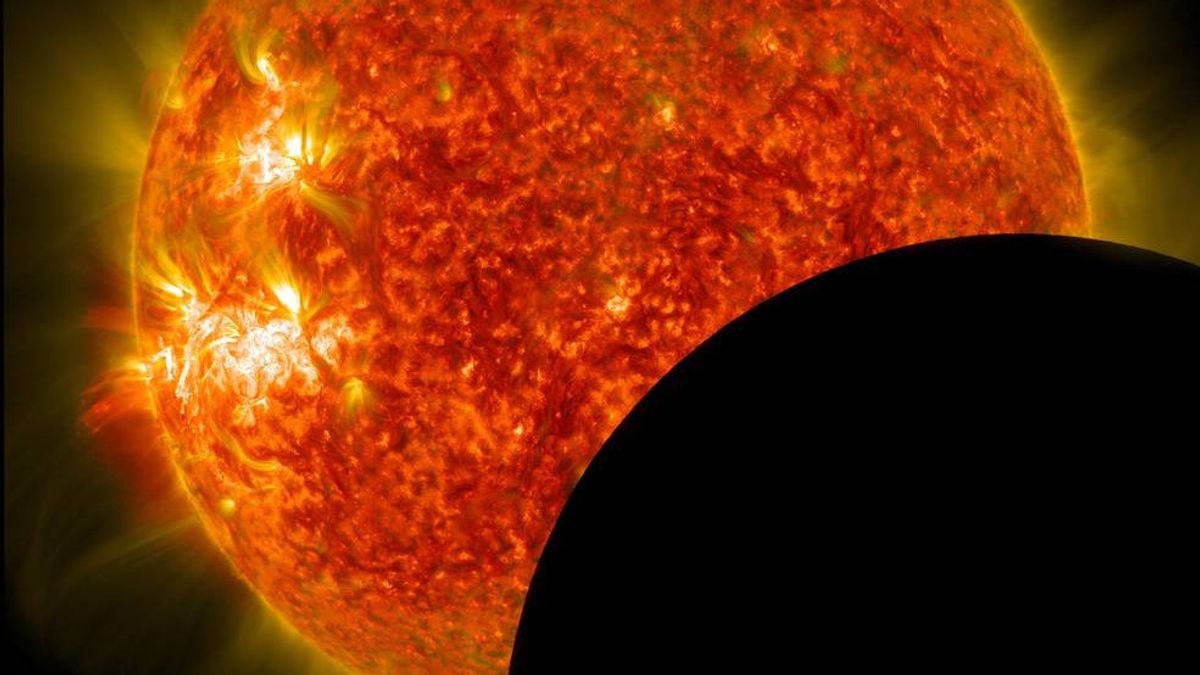JAKARTA - Next week, on April 20, the afternoon sky of Indonesia will be presented with the rare phenomenon of a Hybrid Solar Eclipse, which is two eclipses that occur at once.
A hybrid solar eclipse occurs when the Sun, Moon, and Earth are exactly aligned so that in certain places the Moon's disk will occur, which is smaller than the Sun's disk.
In certain other locations, there will also be events that the Moon's disk that can be seen from Earth is the same as the Sun's disk.
As a result, during the peak of the eclipse in a certain place, the sun will appear like a ring, which is dark in the middle and bright on the edges, while in certain other places it will appear as if the sun is covered by the moon.
The event will feature a Total Solar Eclipse and annular Solar Eclipse, which occur sequentially as a single phenomenon.
According to the Meteorology, Climatology, and Geophysics Agency (BMKG), quoted on Wednesday, April 12, this hybrid solar eclipse is relatively rare.
When a Hybrid Solar Eclipse occurs, three types of Moon shadows will form, namely antumbra, penumbra and umbra. In the region where the antumbra passes, an annular solar eclipse will appear.
Meanwhile in the penumbra, a partial solar eclipse will occur. Then in certain other areas that the umbra passes, a total solar eclipse will be visible.
However, the position of the observation will also affect the magnitude of the eclipse to be observed. So the BMKG said, the public cannot see both eclipses simultaneously and in the same location.
In Indonesia itself, a partial solar eclipse can be observed in Aceh (10.43 a.m. Western Indonesian Time or WIB), North Sumatra (10.24 a.m.WIB), West Sumatra (11.40 a.m. WIB), South Sumatra (10.42 a.m. WIB), Riau (10.47 a.m. WIB), Bengkulu (10.41 a.m. WIB), Jambi (10.43 a.m. WIB), Riau Islands (10.53 a.m. WIB), Lampung (10.41 a.m. WIB), Bangka Belitung (10.50 a.m. WIB), Banten (10.43 a.m. WIB), West Java (10.43 a.m. WIB), Central Java (10.46 a.m. WIB), East Java (10.49 a.m. WIB), DI Yogyakarta (10.48 a.m. Central Indonesian Time or WITA), West Kalimantan (11.00 a.m. WITA), Central Kalimantan (11.00 a.m. WITA), South Kalimantan (12.05 p.m. WITA), East Kalimantan (12.12 p.m. WITA), and North Kalimantan (12.25 p.m. WITA) and Bali (11.55 a.m. WITA).
In addition, West Nusa Tenggara (11.58 a.m. WITA) and East Nusa Tenggara (12.02 p.m. WITA), West Sulawesi (12.14 p.m. WITA), South Sulawesi (12.12 p.m. WITA), Central Sulawesi (12.22 p.m. WITA), North Sulawesi (12.33 p.m. WITA) and Southeast Sulawesi (12.18 p.m. WITA), Gorontalo (12.29 p.m. WITA), Maluku (13.24 p.m. Eastern Indonesian Time or WIT), North Maluku (13.29 p.m. WIT), Papua (13.51 p.m. WIT) and West Papua (13.45 p.m. WIT). Even in DKI Jakarta, the public can watch at 10.45 a.m. WIB.
另请阅读:
Meanwhile, the Total Solar Eclipse can only be observed in the Biak area and Kisar Island, between 13.57 p.m. WIT and 13.22 p.m. WIT, which lasts for a little over 1 minute.
Unfortunately, the Ring Solar Eclipse cannot be observed from Indonesia. In addition, the BMKG warns the public not to watch the process of the solar eclipse directly because the sun's radiation can damage the eyes.
If you want to see it, the public should use special glasses that use filters, or can see it directly through the BMKG streaming service here.
The English, Chinese, Japanese, Arabic, and French versions are automatically generated by the AI. So there may still be inaccuracies in translating, please always see Indonesian as our main language. (system supported by DigitalSiber.id)












